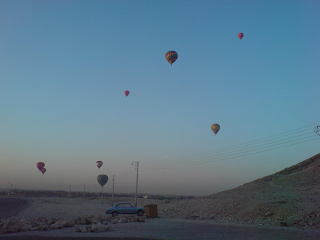



The Valley Of The Queens
The Valley of the Queens, in Arabic Wadi al-Malakat, in ancient times was called Ta Set Neferu, a phrase that can mean The Place of Beauty and also The Place of Royal Children and Wives. It was used in the New Kingdom as a burial place for several royal wives, princesses, and princes. It is a lovely place, this small, Ushaped wadi, curving south and west. Rugged limestone cliffs jut upward, their strata turning and twisting in dramatic contrast to the horizontal beds of other Theban hills.
There is a small cave at the base of these cliffs and when it rained, water would pour into it and then flow through the valley. (The watercourse follows the left side of the modern road and footpath.) Some Egyptologists believe it was this feature that caused the valley to be selected for royal burials: the cave represented the womb of Hathor, the celestial cow, and water meant fertility. Burial here would by a physical symbol of rebirth in the afterlife.The valley’s floor rises only slightly and is covered with undulating hillocks into which tomb entrances could easily be dug.
About ninety tombs have been located in the valley, some of them simple pit tombs, others with corridors along a straight or L-shaped axis with small side chambers. A few, mostly from the reign of Rameses II, have pillared halls, stairways as well as corridors, and large burial chambers. Those of Dynasty 20 are more like the smaller, late New Kingdom tombs in the Valley of the Kings: nearly-level corridors, with an occasional side chamber, leading to a small, rectangular burial chamber.
The three tombs in the Valley of the Queens that are open today are of the latter type. At least ten of the tombs begun in the valley were never finished, probably because poor quality bedrock forced workmen to rethink their plans. That same poor stone meant that heavy layers of plaster had to be applied before walls could be decorated. Some of it fell of its own weight;more was destroyed by occasional flash floods. Well over sixty per cent of the tombs known today are anonymous because such damage has erased evidence of names or titles.
There was continued activity in the valley after the New Kingdom: small tombs continued to be dug, and in the fourth century AD, a Christian monastery called Dayr Rumi was built. Its broken walls can still be seen to the right (west) as one enters the valley from the parking lot. Excavation of the Valley of the Queens was undertaken by Ernesto Schiaparelli of the Egyptian Museum in Turin between 1903 and 1906. His work was highly successful and most of the named tombs we know today, including the famous tomb of Queen Nefertari, were discovered by him and his staff.
More recently, French archaeologists have been working here to clear away the rubble and overburden that covers the limestone bedrock. It is the only part of the Theban Necropolis to be so thoroughly explored. Three tombs are currently open in the Valley of the Queens, all from the reign of Rameses III, whose memorial temple lies only a kilometer away, at Madinat Habu.
The tombs are similar in content and style, while their simple architecture and decoration offer an interesting contrast to the more complex monuments of that king in the Valley of the Kings— and indeed, to the more heavily-decorated tombs of the officials and courtiers who worked as tutors, wet-nurses, and compatriots.From 1995 until 2003 a fourth tomb was also open to tourists, that of Queen Nefertari, principal wife of Rameses II. It is considered by many to be the most beautifully painted tomb in all of Egypt. But it is now closed because of concerns for its protection.




No comments:
Post a Comment